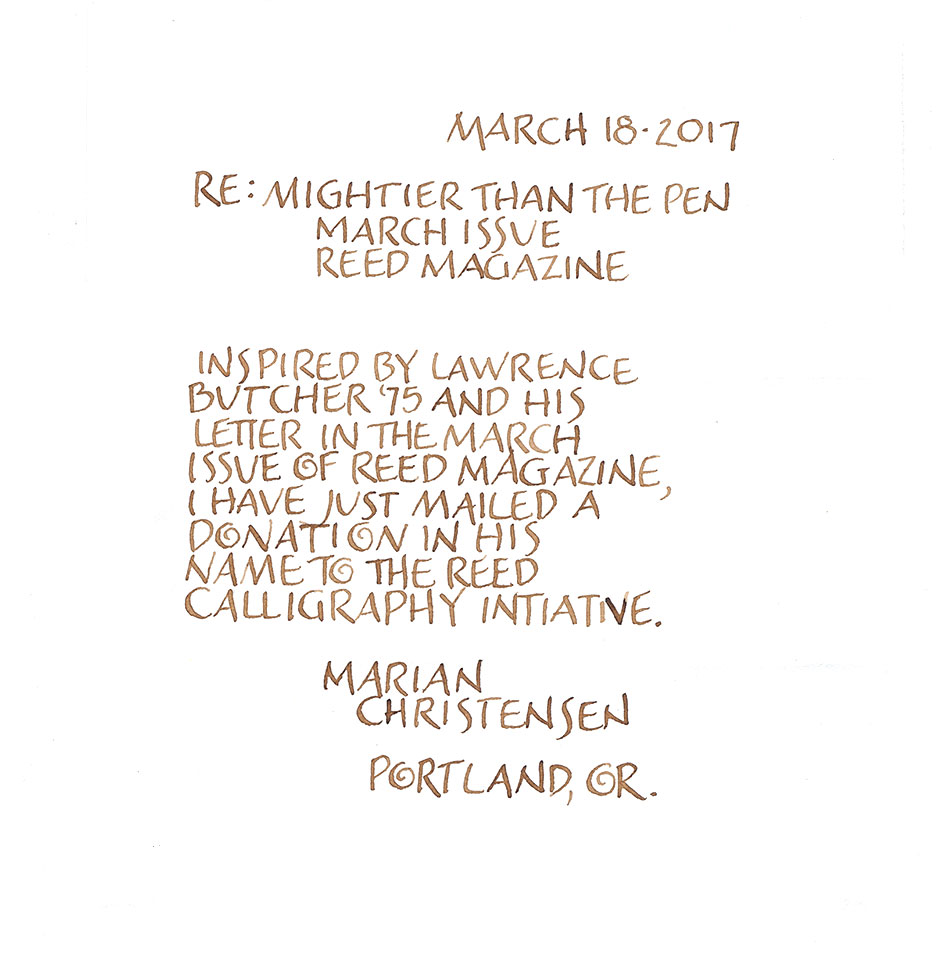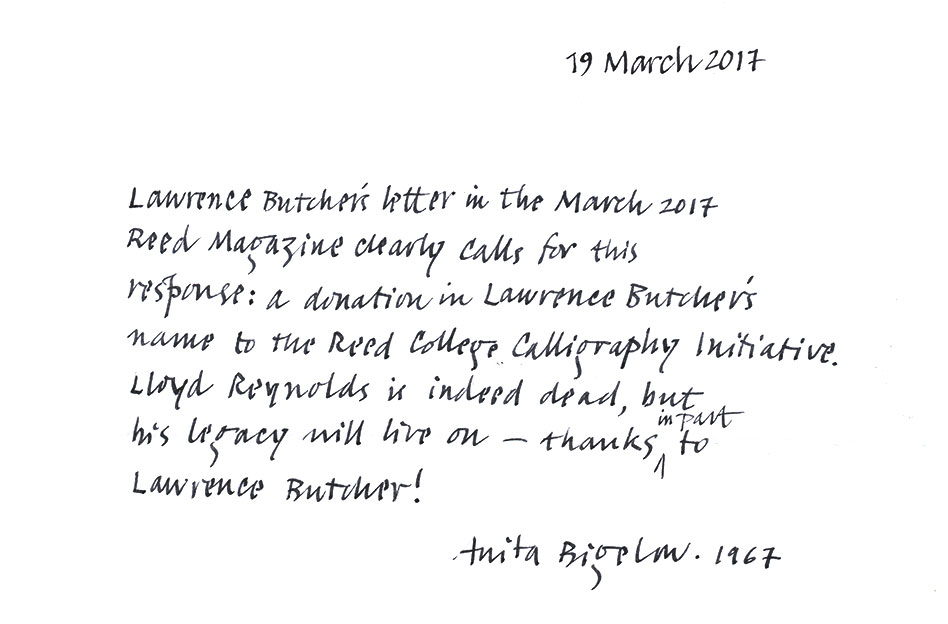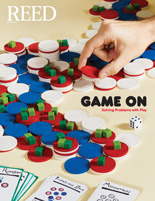
IRIS login | Reed College home Volume 96, No. 2: June 2017
Calligraphy

Many thanks to Lawrence Butcher ’75 for his critique of formal handwriting (Letters, March 2017), though I do think deluded self-appreciation and lack of redeeming social value are not unique to calli-
graphy. What is unique is the economy of effort traditional writing affords to low-tech recorded speech. Audio engineers are the contemporary equivalent. The handwritten letter is a couture response to content, and it ain’t necessarily the ruffles and flourishes writing masters used to lure students after Gutenberg automated their game. The pen point is the exact equivalent of the cutting stylus on a master recording device. Working consciously since 1952, I comprehend a writing tool as a musical instrument that can be played silently under any circumstances and writing itself as a subtly percussive exercise.
Speed is a legitimate variable related to content. Traditional scripts remain legible when they decay under pressure of production. The content of a trained scrawl can be retrieved by repeating the gestures of the writer. The traditional sequence and direction of writing strokes are simple to learn and most valuable when circumstances are most demanding. Consider communicating with lumber crayon on the side of a building after a natural disaster: a decipherable message may be the only connection to one’s personal future. Renaissance italic military orders are far more legible than 19th-century copperplate commands.
Faces and fonts are successive applications of the original written forms that are embedded in each iteration. Roman letters descend from handwritten models that evolved under varying cultural circumstances and are the oldest uninterrupted system of graphic indication available to humanity.
I have enjoyed my share of letters that looked like waltzing pigs, but I have never seen a student who could be described as one. Thanks again for supplying the disdain that has been a crucial element of the calligraphic revival since its inception in the 19th century. Working with letterforms without knowing their history is like practicing medicine without knowing anatomy.
Chris Emerson ’66
Seattle, Washington

I read with mounting fury the smarmy, overweening letter from an ignorant Reedie by the name of Butcher. What a shame that he did not avail himself of Lloyd Reynolds’s [English and art 1929–69] legacy of beauty, discipline, and awe! True, he must have come after Lloyd left, so he was unable to participate directly in or benefit from, his lively, broad-reaching classes, but it hardly qualifies him to judge so fiercely. I came to Reed from the East Coast (and have lived in the Northwest ever since) because I had read Richard Neuberger’s article in the Saturday Evening Post that spoke highly of Lloyd Reynolds and his Graphic Arts Workshop. I wanted to study with him. Lloyd became my mentor and friend. After leaving Reed as a student, I was a photographer for Reed College publications for many years and saw the unifying effect of calligraphed signs all over campus. I also taught at Catlin Gabel and initiated the first italic writing program, grades 1–6, as a curriculum subject. We found that the children wrote with italic when they were proud of their work, and also they retained information better. If you write something, your eyes, mind, and fingers help you to remember. Since then, I have taught history through historic alphabets to students 6 to 66 years old, from short intensives to ongoing classes that sometimes continued for years—on a ship’s deck, in my studio, on kitchen tables, for arts organizations. Few of my students have become skilled calligraphers, it’s true, but all tell me how much it enriched their lives, awakened them to the ordinary, to unexpected beauty. So, keep up the good work, Chris!
Wyn Berry ’57
Vashon, Washington
I understand Lawrence Butcher’s frustration with Lloyd Reynolds as a Reed superhero. I too began at Reed after Lloyd’s tenure, which ended in 1969. A while back, curious as to his popularity with Reed Magazine, I googled Lloyd to see what the fuss was all about. I can understand the fuss. Lloyd’s classes, available on YouTube, present a way of engaging with history from a vocational perspective. Writing was a privilege in the old days, and Lloyd’s classes remind us of that.
As for calligraphy being dead, the artistic value of the script one uses is as current now as it was then. Steve Jobs, in his commencement address to Stanford students, said it was the calligraphy at Reed that was partially responsible for him producing computers: “Throughout the campus, every poster, every label on every drawer, was beautifully hand calligraphed.” And while Jobs was at Reed after Reynolds, he probably dropped in on the calligraphy class of Robert Palladino [art 1969–84], Reynolds’s protégé: “I learned about serif and sans serif typefaces, about varying the amount of space between different letter combinations, about what makes great typography great. It was beautiful, historical, artistically subtle in a way that science can’t capture, and I found it fascinating.”
Combine the importance of writing with a well-informed and gentle approach, and one can see the appeal of Reynolds’s classes. Far from being irrelevant, asking why Lloyd Reynolds is relevant to Reed is as Reed as Reed gets. Good question.
Bill Owen ’84
Beaverton, Oregon
Lawrence Butcher complains that calligraphy has “utter lack of value to society.” Lloyd Reynolds’s teaching was not limited to calligraphy but spanned five thousand years of writing as the art and technology on which civilization is based. I studied with Reynolds in 1966–67, and my design partner, Kris Holmes ’72, studied with Robert Palladino, Reynolds’ successor at Reed, in 1970–72, and also with Reynolds. From what we learned from Lloyd and Bob, Ms. Holmes and I designed the Lucida digital typefaces that were long used in Apple’s OS X system user interface. Every day for 14 years, up to 80 million Mac users read and wrote with those fonts. We also designed Apple Chancery, based on Reynolds’s italic handwriting. Microsoft has distributed Lucida fonts with Windows and Office since the 1990s, around 2 billion of them over 25 years. Sun Microsystems distributed millions of Lucida fonts with the Solaris operating system and with software for Java Language developers. Lucida Math fonts are used for mathematical and technical publishing with the TeX system. At Reed, I studied with great professors, including David French [anthropology 1947–88], Gail Kelly ’55 [anthropology 1960–2000], and Richard Jones [history 1941–86]. Often I think of what I learned from them, whether reading Native American literature, pondering the anthropology of social media, or browsing the Histories of Herodotus of Halicarnassus, who wrote so that “things done by man may not be forgotten in time.” Yet, it was Reynolds’s teaching that gave me a fascinating career. If Mr. Butcher ever used Sun Solaris, Mac OS X, or Windows operating systems, he might have had to quit reading and writing had he realized that the fonts he was using came from Lloyd Reynolds’s teaching and calligraphy.
Charles Bigelow ’67
Rochester, New York
I was pleasantly surprised to discover Lawrence Butcher’s criticism of Lloyd Reynolds in the March Reed Magazine. I had thought Lloyd’s reputation was so well established that he was beyond criticism. I took an art appreciation class from Lloyd in 1954. His theory was that art appreciation was all about lines, shapes, and balance—left-brain concepts. I thought then— and still do—that art appreciation is about what feelings the work expresses or what feelings the work intends the audience to feel. So in the major project to analyze 10 works of art, I discussed feelings. Lloyd gave me a D for the course. Such respect for an alternate point of view!
But Lloyd was simply expressing what is wrong with Reed—the hopeless overemphasis on the left brain. The class of 1957 had 250 freshmen, and 73 of us graduated. Why? Because so many of us were emotional messes, even worse than me, who primarily majored in poker. Where does Reed feed our right brains? I’ve always thought that Reed needs something in the way of emotional support groups or encounter groups required of all students. As for Lawrence Butcher, because of his left-brain-only training, he doesn’t notice that calligraphy is beautiful.
Don Schuman ’57
Bend, Oregon
I was a bit puzzled by the letter from Mountain View that complained about the abundance of calligraphy. How can that even be offensive? At a recent visit to the newly refurbished Portland Japanese Gardens, I read about the samurai’s respect for the Bunbu-Ryodo, the Twofold Path of the Sword and the Pen. I wanted to share an excerpt here: “To acquire the inner strength needed to succeed, a warrior needed not only skill in the martial arts, but also in the cultured arts of tea ceremony, poetry writing and calligraphy–all influenced by the disciplined practice of Zen Buddhism.”

LATEST COMMENTS
steve-jobs-1976 I knew Steve Jobs when he was on the second floor of Quincy. (Fall...
Utnapishtim - 2 weeks ago
Prof. Mason Drukman [political science 1964–70] This is gold, pure gold. God bless, Prof. Drukman.
puredog - 1 month ago
virginia-davis-1965 Such a good friend & compatriot in the day of Satyricon...
czarchasm - 4 months ago
John Peara Baba 1990 John died of a broken heart from losing his mom and then his...
kodachrome - 7 months ago
Carol Sawyer 1962 Who wrote this obit? I'm writing something about Carol Sawyer...
MsLaurie Pepper - 8 months ago
William W. Wissman MAT 1969 ...and THREE sisters. Sabra, the oldest, Mary, the middle, and...
riclf - 10 months ago